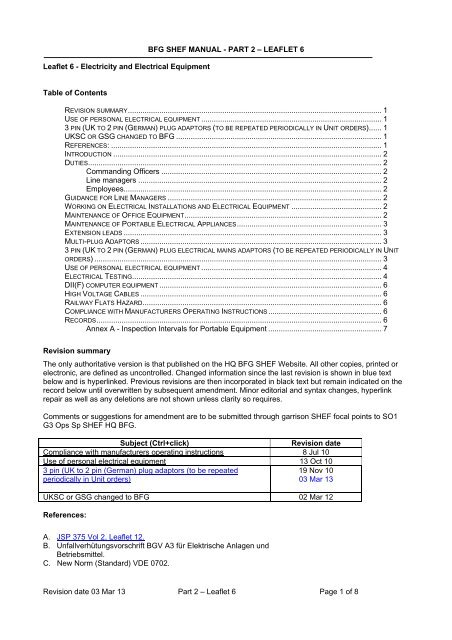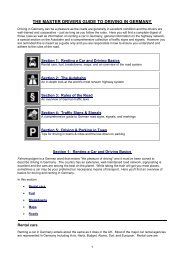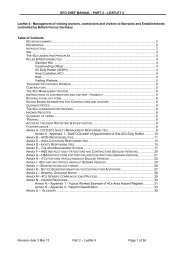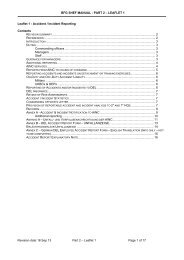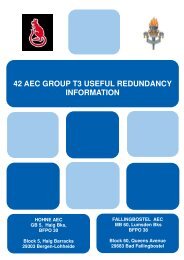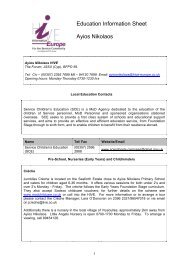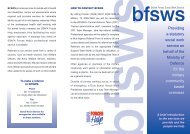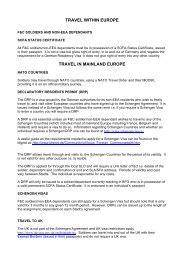Leaflet 6 - Electricity and Electrical Equipment.pdf - BFGnet
Leaflet 6 - Electricity and Electrical Equipment.pdf - BFGnet
Leaflet 6 - Electricity and Electrical Equipment.pdf - BFGnet
You also want an ePaper? Increase the reach of your titles
YUMPU automatically turns print PDFs into web optimized ePapers that Google loves.
<strong>Leaflet</strong> 6 - <strong>Electricity</strong> <strong>and</strong> <strong>Electrical</strong> <strong>Equipment</strong><br />
BFG SHEF MANUAL - PART 2 – LEAFLET 6<br />
Table of Contents<br />
REVISION SUMMARY......................................................................................................................... 1<br />
USE OF PERSONAL ELECTRICAL EQUIPMENT ...................................................................................... 1<br />
3 PIN (UK TO 2 PIN (GERMAN) PLUG ADAPTORS (TO BE REPEATED PERIODICALLY IN UNIT ORDERS)...... 1<br />
UKSC OR GSG CHANGED TO BFG .................................................................................................. 1<br />
REFERENCES: ................................................................................................................................. 1<br />
INTRODUCTION ................................................................................................................................ 2<br />
DUTIES............................................................................................................................................ 2<br />
Comm<strong>and</strong>ing Officers ......................................................................................................... 2<br />
Line managers .................................................................................................................... 2<br />
Employees........................................................................................................................... 2<br />
GUIDANCE FOR LINE MANAGERS ...................................................................................................... 2<br />
WORKING ON ELECTRICAL INSTALLATIONS AND ELECTRICAL EQUIPMENT ........................................... 2<br />
MAINTENANCE OF OFFICE EQUIPMENT.............................................................................................. 2<br />
MAINTENANCE OF PORTABLE ELECTRICAL APPLIANCES..................................................................... 3<br />
EXTENSION LEADS ........................................................................................................................... 3<br />
MULTI-PLUG ADAPTORS ................................................................................................................... 3<br />
3 PIN (UK TO 2 PIN (GERMAN) PLUG ELECTRICAL MAINS ADAPTORS (TO BE REPEATED PERIODICALLY IN UNIT<br />
ORDERS) ......................................................................................................................................... 3<br />
USE OF PERSONAL ELECTRICAL EQUIPMENT ...................................................................................... 4<br />
ELECTRICAL TESTING....................................................................................................................... 4<br />
DII(F) COMPUTER EQUIPMENT .......................................................................................................... 6<br />
HIGH VOLTAGE CABLES ................................................................................................................... 6<br />
RAILWAY FLATS HAZARD.................................................................................................................. 6<br />
COMPLIANCE WITH MANUFACTURERS OPERATING INSTRUCTIONS ...................................................... 6<br />
RECORDS........................................................................................................................................ 6<br />
Annex A - Inspection Intervals for Portable <strong>Equipment</strong> ...................................................... 7<br />
Revision summary<br />
The only authoritative version is that published on the HQ BFG SHEF Website. All other copies, printed or<br />
electronic, are defined as uncontrolled. Changed information since the last revision is shown in blue text<br />
below <strong>and</strong> is hyperlinked. Previous revisions are then incorporated in black text but remain indicated on the<br />
record below until overwritten by subsequent amendment. Minor editorial <strong>and</strong> syntax changes, hyperlink<br />
repair as well as any deletions are not shown unless clarity so requires.<br />
Comments or suggestions for amendment are to be submitted through garrison SHEF focal points to SO1<br />
G3 Ops Sp SHEF HQ BFG.<br />
Subject (Ctrl+click)<br />
Revision date<br />
Compliance with manufacturers operating instructions 8 Jul 10<br />
Use of personal electrical equipment 13 Oct 10<br />
3 pin (UK to 2 pin (German) plug adaptors (to be repeated<br />
periodically in Unit orders)<br />
19 Nov 10<br />
03 Mar 13<br />
UKSC or GSG changed to BFG 02 Mar 12<br />
References:<br />
A. JSP 375 Vol 2, <strong>Leaflet</strong> 12.<br />
B. Unfallverhütungsvorschrift BGV A3 für Elektrische Anlagen und<br />
Betriebsmittel.<br />
C. New Norm (St<strong>and</strong>ard) VDE 0702.<br />
Revision date 03 Mar 13 Part 2 – <strong>Leaflet</strong> 6 Page 1 of 8
BFG SHEF MANUAL - PART 2 – LEAFLET 6<br />
Introduction<br />
1. <strong>Electricity</strong>, when properly controlled <strong>and</strong> used, is a safe <strong>and</strong> efficient form of energy. However if<br />
electricity is misused it can be dangerous causing serious harm to people <strong>and</strong> equipment. Consequently,<br />
those who work with or manage electrical installations <strong>and</strong>/or equipment shall comply with the stringent<br />
requirements of References A <strong>and</strong> B.<br />
2. Excluded from this Chapter is fixed electrical equipment already maintained in accordance with an<br />
approved formal scheduled procedure (i.e. DE Safety Rules <strong>and</strong> Procedures 01). Employees working with<br />
this equipment will comply with formal safe systems of work.<br />
Duties<br />
Comm<strong>and</strong>ing Officers<br />
3. Comm<strong>and</strong>ing Officers are to ensure that their unit has adequate arrangements for the effective<br />
management of the risk associated with electricity in the workplace. These arrangements are to be<br />
monitored <strong>and</strong> reviewed accordingly.<br />
Line managers<br />
4. Line managers are to ensure that all persons are protected from the hazards associated with the use of<br />
electrical equipment within their workplace. The main hazards are electrocution, burns, fire, explosion <strong>and</strong><br />
indirect injuries such as falls from height when in contact with electricity.<br />
Employees<br />
5. Employees are to check that prior to use the electrical equipment appears to be in a serviceable<br />
condition, <strong>and</strong> report any faults with the equipment or system to the line manager. They are to comply with<br />
the appropriate risk assessment <strong>and</strong> formal safe systems of work.<br />
Guidance for Line Managers<br />
6. Line managers must ensure that where a risk of injury is foreseeable then employees receive adequate<br />
training <strong>and</strong> information that allows them to use or work safely on electrical equipment or systems.<br />
7. Advice must be sought from the USA where DEL <strong>and</strong> military employees interface <strong>and</strong> electrical<br />
equipment is subject to inspection <strong>and</strong> maintenance by a competent person.<br />
Working on <strong>Electrical</strong> Installations <strong>and</strong> <strong>Electrical</strong> <strong>Equipment</strong><br />
8. No work is to be carried out to any electrical installation or fixed equipment regardless whether live or<br />
completely isolated <strong>and</strong>/or disconnected without the express consent of the appropriate authority (ie. DE(E)).<br />
Only authorised, trained, experienced <strong>and</strong> competent personnel are allowed to work on electrical<br />
installations <strong>and</strong> fixed equipment. This must also be in accordance with the safe system of work, which may<br />
include a permit to work system. Reference A provides further guidance.<br />
9. In accordance with References B & C it is not permitted to carry out any unauthorised alterations or<br />
modifications to any portable electrical equipment (eg. cutting off a sealed plug <strong>and</strong> replacing with a nonsealed<br />
one or removing plug <strong>and</strong> cable complete from the body of the equipment <strong>and</strong> replacing) unless done<br />
by a fully qualified <strong>and</strong> competent electrician. Carrying out such work may invalidate any manufacturer’s<br />
guarantees <strong>and</strong> the competent electrician may be liable should any related malfunction occur.<br />
Maintenance of Office <strong>Equipment</strong><br />
10. Office staff with the minimum of training <strong>and</strong> supervision can generally carry out simple maintenance<br />
(changing cartridges, dealing with paper jams etc) on general office equipment such as photocopiers,<br />
computers <strong>and</strong> printers. Where guards or other safety devices have to be removed or disconnected then<br />
only a competent person is to carry out the maintenance. Care should be taken however, when changing<br />
overhead light bulbs that may require the use of ladder/steps, where the additional hazard of working at<br />
height must also be considered.<br />
Revision date 03 Mar 13 Part 2 – <strong>Leaflet</strong> 6 Page 2 of 8
BFG SHEF MANUAL - PART 2 – LEAFLET 6<br />
Maintenance of Portable <strong>Electrical</strong> Appliances<br />
11. All portable electrical appliances are to be maintained to prevent danger to employees <strong>and</strong> others. This<br />
implies that best practice is that all equipment has to be identified, marked with a unique number <strong>and</strong><br />
entered into an electrical equipment register. It then has to be subject to a maintenance regime based on the<br />
equipment held, the circumstances of its use <strong>and</strong> the potential related risk.<br />
12. There is little difference between Host Nation legislation <strong>and</strong> its UK equivalent in defining who is<br />
competent to carry out electrical maintenance. Each also provides a table of maintenance periodicity <strong>and</strong><br />
allows maintenance periods to be extended depending on satisfactory maintenance results.<br />
13. Formal maintenance of electrical appliances is to be carried out by a competent person. However the<br />
line manager can reduce risk by implementing a simple system of visual inspection by the user before <strong>and</strong><br />
after use to identify obvious physical damage to the appliance <strong>and</strong> associated electrical system. Reference<br />
A provides detailed guidance.<br />
Extension leads<br />
14. Extension leads are classed as portable electrical appliances <strong>and</strong> shall be inspected, tested <strong>and</strong><br />
maintained accordingly. These are used widely throughout BFG as a means to increase the number of<br />
socket outlets <strong>and</strong>/or provide an electrical supply to an area away from the socket outlet. Care must be taken<br />
to ensure that the current drawn by attached appliances never reaches the maximum permitted load for the<br />
lead or the socket <strong>and</strong> that cables do not create a fall or trip hazard. Leads must never be used in a coiled<br />
position as this increases the risk of overheating <strong>and</strong> fire. The use of extension leads is to be discouraged<br />
<strong>and</strong> should only be considered as a temporary measure for short-term use. In the long term, in so far as is<br />
reasonably practicable, arrangements should be made to have fixed socket outlets fitted within<br />
buildings/facilities.<br />
15. Under no circumstances shall extension leads be added together to extend distance between<br />
equipment <strong>and</strong> the socket outlet.<br />
Multi-plug Adaptors<br />
16. These adaptors allow more than one cable to be plugged into a single outlet. Use of these adaptors in<br />
the workplace is prohibited at all times.<br />
3 pin (UK to 2 pin (German) plug electrical mains adaptors (to be repeated periodically in Unit orders)<br />
17. It is common practice for UK based personnel to use electrical plug mains adaptors to enable a 3 pin<br />
UK appliance to be plugged into a German 2 pin socket, normally to avoid cutting off a useable plug <strong>and</strong><br />
perhaps invalidating the warranty. However, not all such adaptors are actually fit for purpose or use with all<br />
appliances.<br />
18. To meet the duty of care, it is BFG policy that all electrical adaptors used within the workplace or<br />
within residential accommodation must be fit for purpose <strong>and</strong> safe to use. UK 3 pin to German 2 pin adaptors<br />
connected to appliances that have a high amperage rating; for example, kettles, washing machines, washing<br />
up machines <strong>and</strong> tumble dryers must therefore at least be clearly marked 1 ‘13/16 Amp’ <strong>and</strong> ‘max 3.3Kw’ <strong>and</strong><br />
‘240v’ <strong>and</strong> be earthed on both sides. Such adaptors, which are available from all main NAAFI shops, can<br />
normally also be used for most types of household appliances unless otherwise stated in the manufacturers<br />
instructions. Adaptors which do not show the amperage <strong>and</strong> the Kw <strong>and</strong> voltage ratings are not to be used in<br />
any circumstances. It is best practice to have all adaptors showing ratings <strong>and</strong> rated as described above,<br />
thus allowing flexibility of use <strong>and</strong> reducing risk.<br />
19. Appliances which require high amperage, or which must be earthed, whether using an adaptor or not,<br />
must be plugged into their own wall socket <strong>and</strong> never into a multi-socket extension lead. They must not be<br />
connected to adaptors that can take two UK 3 pins plugs as this can overload the socket.<br />
1 Note that regulations do not require mains plugs or socket outlets for domestic use to be marked with CE (exempt through the Low<br />
Voltage Directive 2006/95/EC ), VDE or BS st<strong>and</strong>ards.<br />
Revision date 03 Mar 13 Part 2 – <strong>Leaflet</strong> 6 Page 3 of 8
BFG SHEF MANUAL - PART 2 – LEAFLET 6<br />
20. Travel adaptors, such as those for multi-country use, are not suitable for appliances that require an<br />
earth connection <strong>and</strong>, as the name implies, are really for travel use. They may only be used with double<br />
insulated appliances; these will be marked with a symbol . Therefore appliances that require an earth<br />
connection or high amperage should be connected to the mains by use of an appropriately marked <strong>and</strong><br />
earthed adaptor. The MOD supplied multi-pin travel adapter NSN Z32 5935 99 147 2536 is only to be used<br />
for travelling purposes <strong>and</strong> not for permanent use.<br />
21. The use of an adaptor that is of sub st<strong>and</strong>ard or inferior quality may overheat causing injury or<br />
damage to the appliance, the wall sockets <strong>and</strong> electrical circuits <strong>and</strong> possibly in worse case a fire.<br />
22. The use of inappropriate adaptors in barracks or in single living accommodation is not permitted. Any<br />
such adapters must be permanently taken out of use <strong>and</strong> the socket used visually checked for damage,<br />
which must be reported. Damaged sockets must not be used until professionally repaired <strong>and</strong> declared safe<br />
to use.<br />
23. If there are any concerns about electrical safety at your place of work or in your accommodation then<br />
this is to be reported immediately in accordance with local instructions.<br />
24. Legal advice is that occupants of MoD accommodation (be it in the workplace or at home) will be liable<br />
to the MOD for the cost of repairing any damage caused by improper or inappropriate use, including use<br />
contrary to the guidance set out in this leaflet of electrical adaptors used by the occupants within the<br />
accommodation. The MoD will also seek to recover from such occupants all costs, claims, expenses <strong>and</strong><br />
damages incurred as a result of claims by third parties alleging injury or damage caused by the improper or<br />
inappropriate use of adaptors.<br />
Use of personal electrical equipment<br />
25. It is current MOD policy 2 , confirmed by CESO(A) 3 that the head of an establishment/comm<strong>and</strong>ing<br />
officer shall establish a policy on the use of personal items of electrical equipment. It is not sufficient to allow<br />
persons to bring onto MOD property any items of electrical equipment ‘at their own risk’. A dangerous piece<br />
of equipment may electrocute any person (not just the owner) <strong>and</strong> a fire or explosion caused by a fault will<br />
also have consequences which affect others.<br />
26. The use of personal items of electrical equipment in the workplace should be discouraged, as their<br />
suitability for use <strong>and</strong> st<strong>and</strong>ard of inspection, maintenance <strong>and</strong> repair cannot be easily guaranteed.<br />
27. There are areas such as accommodation areas for service personnel where it is impossible to<br />
instigate a full inspection <strong>and</strong> testing regime. A risk assessment must be carried out <strong>and</strong> suitable <strong>and</strong><br />
sufficient control measures put in place.<br />
28. Possible control measures may include:<br />
a. Permission required for items of electrical equipment.<br />
b. Visual checks made of equipment on a regular basis.<br />
c. Removal of unsafe equipment.<br />
<strong>Electrical</strong> Testing<br />
29. <strong>Electrical</strong> testing using portable appliance testers (PAT) where the interpretation of the read out<br />
requires electrical knowledge is only to be carried out by a competent person. Host Nation legislation <strong>and</strong><br />
st<strong>and</strong>ards shown at References B & C, differ from the UK equivalent in that it states “inspections/testing must<br />
be carried out by qualified electricians or, where the correct test equipment is used, with, for instance, a<br />
2<br />
JSP 375 Vol 2 <strong>Leaflet</strong> 12 Annex A<br />
3<br />
CESO(A) email to HQ BFG Fri 08/10/2010 16:41<br />
Revision date 03 Mar 13 Part 2 – <strong>Leaflet</strong> 6 Page 4 of 8
BFG SHEF MANUAL - PART 2 – LEAFLET 6<br />
“good-bad” signal, they may be carried out by persons instructed in electro-techniques under the guidance<br />
<strong>and</strong> supervision of qualified electricians”.<br />
30. However, the Unfallkasse des Bundes (UK Bund) have made the following interpretation: “so long as<br />
the ‘competent person’ has been trained by a fully qualified electrician on the operation procedure of the<br />
PAT, there is no restriction in allowing that person to work independently”. The term “under the guidance <strong>and</strong><br />
supervision” basically means that the qualified electrician needs to be fully satisfied that the individual is<br />
competent to carry out the testing required <strong>and</strong> to check that they are carrying out the work to a satisfactory<br />
st<strong>and</strong>ard. There is no intention to ensure the person is constantly monitored or shadowed during the<br />
inspections/testing of the equipment.<br />
31. The qualified electrician conducting the training can be Military, UKBC DEL or DEP but consideration<br />
needs to be given to ensure there are no language difficulties that may affect underst<strong>and</strong>ing of the<br />
instructions.<br />
32. This interpretation effectively differs from the UK requirement in that the operator receives training on<br />
the use of the equipment by a person deemed “competent” to provide it but that person does not need to be<br />
a qualified electrician. They must however, supervise the operator until they are satisfied that they are fully<br />
competent. The definition of competence is described clearly at Part 2, <strong>Leaflet</strong> 3 of this Manual. For Military,<br />
UKBC or DEP pers, PAT testing instruction may in exceptional circumstances be provided under the<br />
authority of SHEF, G3 OpsSp, HQ BFG by a MoD civilian contractor<br />
33. Based on the above guidance, the following procedure should be followed:<br />
a. Only qualified electricians must be allowed to train DEL personnel on how to carry out PAT in<br />
the workplace.<br />
b. Qualified electricians are also permitted to train Military personnel, UKBCs <strong>and</strong> DEPs on how to<br />
carry out PAT in the workplace.<br />
Note: qualified electricians can be DEL, Military, DEP or UKBC. See paragraph 30 above.<br />
c. UK “competent” persons (not qualified electricians) are NOT permitted to train DEL on how to<br />
carry out PAT in the workplace.<br />
d. UK “competent” personnel (not qualified electricians) ARE permitted to train Military personnel,<br />
UKBCs <strong>and</strong> DEPs on how to carry out PAT in the workplace.<br />
34. The st<strong>and</strong>ard MOD service supplied PAT has a multi-functional capability in that it can provide the<br />
basic yes/no reading (common to the most basic monitors) but also a full analysis function (for use by the<br />
fully qualified electrician) including the provision of computer interface <strong>and</strong> print-out capability. This<br />
equipment comes complete with user manual <strong>and</strong> help menus built into the equipment. The supplier (Test<br />
<strong>Equipment</strong> Management Organisation (TEMO) from RAF Brampton) states that no specific formal training<br />
package is available or required for the operation of this equipment as it is considered simple to operate.<br />
They also stated that current operators of similar PAT equipment at Gars/Units should be more than capable<br />
of meeting the required operating competencies.<br />
35. The PAT details are as follows:<br />
a. PAT (“Seaward,” Model: “Super Nova Plus”): NSN is 6625-99-284-3037.<br />
b. Printer: NSN is 6625-99-724-3377.<br />
c. Accessory Bag: NSN is 6625-99-724-9080.<br />
d. Continental Adaptor: NSN is Z4 6625-99-567-7936, Part No. 283A975.<br />
e. Seaward Printer Tape Black on Yellow: NSN is 6625-99-380-6926<br />
Note: Requests should be directed through the USA. The PAT comes complete with German 2-pin<br />
plug <strong>and</strong> lead. The adaptor is required for the printer only <strong>and</strong> is not to be used for other equipment.<br />
Revision date 03 Mar 13 Part 2 – <strong>Leaflet</strong> 6 Page 5 of 8
BFG SHEF MANUAL - PART 2 – LEAFLET 6<br />
36. Portable appliance testers must be maintained <strong>and</strong> calibrated according to the manufacturer’s<br />
instructions. Arrangements for maintenance <strong>and</strong> calibration should be arranged through the holding unit<br />
<strong>and</strong>/or USA. Annex A refers to the non-exhaustive types of appliances that will require testing <strong>and</strong> includes<br />
typical guidance on the inspection frequency.<br />
DII(F) computer equipment<br />
37. Atlas (the providers of DII F) equipment) have no contractual duty to carry out PAT Checks. The<br />
equipment (PC, Monitor <strong>and</strong> any printers) are thus considered to be unit held electrical equipment for which<br />
the unit has certain managerial <strong>and</strong> safety responsibilities. These are shown in Reference A Annex A<br />
Appendix 1 thereto, with which units are expected to comply.<br />
High Voltage Cables<br />
38. High voltage power cables can be found above or below ground. The risk of serious injury or even<br />
death from contact with these cables is high <strong>and</strong> line managers must ensure employees are not exposed to<br />
this potential risk. Generally, work should not be carried out in the vicinity of overhead power cables. Should<br />
work have to be carried out in the vicinity of power cables, advice should be sought from the appropriate<br />
USA or GHSWE <strong>and</strong> from DE(E).<br />
Railway Flats Hazard<br />
39. Host nation railway systems employ high voltage power cables. No person required to work on a rail<br />
loading area, rail flats or other processes near such hazards is to be permitted to do so until they have<br />
received information, instruction <strong>and</strong> supervision from competent persons on the risks. Once the vehicle is<br />
loaded, access to the vehicle must be restricted until appropriate railway staff confirms it is safe to do so. At<br />
no time are personnel allowed access to vehicles whilst the train is moving.<br />
40. Attention is also drawn to the Workplace Transport Safety direction contained in <strong>Leaflet</strong> 42 of this part<br />
of the BFG SHEF Manual.<br />
Compliance with Manufacturers Operating Instructions<br />
41. <strong>Electrical</strong> equipment must only be used in accordance with the manufacturers operating instructions.<br />
These must be kept available to those authorised to use the equipment. Particular attention must be given to<br />
maintenance <strong>and</strong> safety instructions.<br />
Records<br />
42. Risk assessments should be retained for 5 years <strong>and</strong> should not be destroyed on reviewed but held in<br />
case of future potential claims as a result of an accident or incident. Training should be carried out <strong>and</strong><br />
recorded in accordance with Reference A. All portable electrical appliances are to be identified <strong>and</strong> marked<br />
with a unique identification number. They are to be recorded in a local electrical register <strong>and</strong> maintained by<br />
the line manager, as outlined at Reference A.<br />
Revision date 03 Mar 13 Part 2 – <strong>Leaflet</strong> 6 Page 6 of 8
BFG SHEF MANUAL - PART 2 – LEAFLET 6<br />
<strong>Leaflet</strong> 6<br />
Annex A - Inspection Intervals for Portable <strong>Equipment</strong><br />
TYPICAL INSPECTION INTERVALS FOR PORTABLE EQUIPMENT<br />
Portable <strong>Electrical</strong> <strong>Equipment</strong><br />
Baths:<br />
Liquid jets/Water suction (suction scrubbing devices).<br />
Extension/Appliance connection cables.<br />
Underwater suction devices/centrifuges.<br />
Building Cleaning:<br />
Vacuum/Polishing <strong>and</strong> brushing/Carpet cleaning appliances.<br />
Extension/Appliance connection cables.<br />
Laboratories:<br />
Rotation evaporators/Mobile analysers/Heaters.<br />
Measuring devices/Mains operated lab equipment.<br />
Table lamps/Mixers.<br />
Extension/Appliance connection cables.<br />
Mass Catering Kitchens<br />
Cutting machines/Coffee makers/Toasters/Hot trolleys.<br />
Hot plates/Rings/Mixers/<strong>Electrical</strong> h<strong>and</strong> appliances etc.<br />
Extension <strong>and</strong> appliance connection cables.<br />
Exceptions: Other kitchens.<br />
Classrooms in schools<br />
<strong>Electrical</strong> machinery in the media area.<br />
Slide/film/daylight projectors/Video appliances etc.<br />
Extension/Appliance connection cables.<br />
<strong>Electrical</strong> machinery in the sphere of textiles.<br />
Irons/Sewing machines.<br />
Fire Brigades / Technical Disaster Help<br />
(for machinery used on exercise <strong>and</strong> in operations):<br />
<strong>Electrical</strong> h<strong>and</strong> appliances/H<strong>and</strong> lamps/Floodlights.<br />
Decanting pumps/Extension <strong>and</strong> appliance connection cables.<br />
Workshops / Building Sites<br />
H<strong>and</strong> <strong>and</strong> building site lights/H<strong>and</strong> drills/Angle grinders.<br />
Belt <strong>and</strong> orbital s<strong>and</strong>ers/H<strong>and</strong>-held circular saws/Jig saws.<br />
Soldering irons/Ventilation appliances/Liquid spray appliances.<br />
Mobile table-top circular saws/Mobile surface planers.<br />
Extraction of (wood) chips/Mixers.<br />
Hedge shears/Chopping machines.<br />
Lawn mowers/Extension <strong>and</strong> appliance connection cables.<br />
Test Deadline<br />
6 Months<br />
12 Months<br />
12 Months<br />
6 Months<br />
12 Months<br />
12 Months<br />
12 Months<br />
12 Months<br />
Revision date 3 Mar 13 Part 2 – <strong>Leaflet</strong> 6 Page 7 of 8
BFG SHEF MANUAL - PART 2 – LEAFLET 6<br />
Offices<br />
See JSP 375 Vol 2 <strong>Leaflet</strong> 12 - Reference A<br />
Laundries<br />
Irons/Mobile ironing machines/Sewing machines.<br />
Extension <strong>and</strong> appliance connection cables.<br />
12 Months<br />
NB: Adapted from Unfallverhütungsvorschrift BGV A3 für Elektrische Anlagen und Betriebsmittel<br />
Revision date 3 Mar 13 Part 2 – <strong>Leaflet</strong> 6 Page 8 of 8


